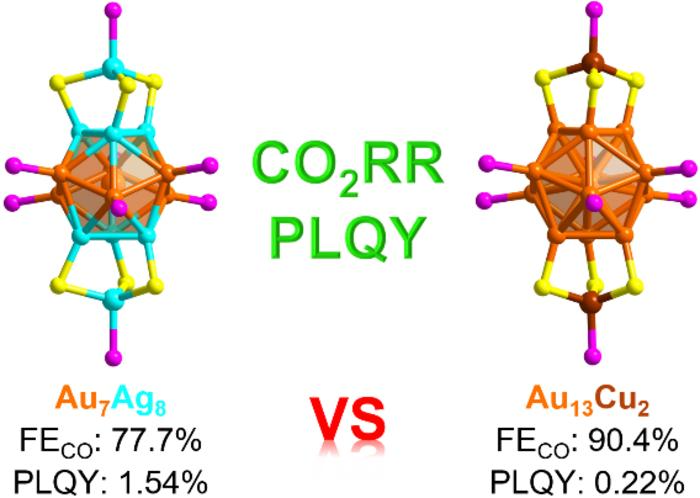A team of researchers has successfully created and determined the crystal structure of a metal nanocluster by providing experimental evidence for the precise design and understanding of nanoclusters with tailored properties at the atomic level in their study. Metal nanoclusters hold significant potential for diverse applications in the biomedical domain.
 The Au7Ag8 metal nanocluster was synthesized and then compared to a nanocluster (Au13Cu2) with a similar structure but different metal composition. Image Credit: Polyoxometalates, Tsinghua University Press
The Au7Ag8 metal nanocluster was synthesized and then compared to a nanocluster (Au13Cu2) with a similar structure but different metal composition. Image Credit: Polyoxometalates, Tsinghua University Press
The study was published in the February 6th, 2024 issue of Polyoxometalates.
Researchers are fascinated by ligand-protected atomically precise metal nanoclusters due to their well-defined atomic structures and exceptional chemical and physical properties. These properties include chirality, luminescence, catalysis, and electrochemistry. Metal nanoclusters show potential as perfect model catalysts because of these properties. Their ultrasmall size bestows them with high catalytic activity and selectivity in numerous catalytic reactions.
Ligand-protected metal nanoclusters are extremely small organic-inorganic nanostructures known for their excellent stability at particular compositions. Their tunable properties make them promising candidates for various applications based on nanotechnology.
Metal nanoclusters with similar structures but different metal compositions offer scientists an exclusive opportunity to study atomic-level metal synergy in depth. To fully exploit the potential of these nanoclusters in numerous applications, scientists must be able to synthesize alloy nanoclusters with similar structures but different metal compositions. This synthesis enables scientists to broadly investigate the factors impacting the properties of the nanoclusters.
Scientists have made remarkable advances in preparing metal nanoclusters with similar structures; however, the availability of these nanoclusters remains limited. The production of such metal nanoclusters represents a vital next step for scientists.
Investigation into alloy nanoclusters has garnered more and more attention among scientists over time. Previous studies have provided scientists with a primary understanding of the source of the optical properties of metal nanoclusters. This understanding enables scientists to gain theoretical guidance for engineering nanoclusters with high photoluminescence quantum yields.
The research team conducted a comprehensive study of the gold-silver nanocluster [Au7Ag8(SPh)6 ((p-OMePh)3P)8]NO3 (Au7Ag8). They produced this nanocluster, examined its crystal structure, and investigated its optical and electrocatalytic properties for carbon dioxide reduction.
The research team employed several techniques, including X-Ray photoelectron spectroscopy, electrospray ionization mass spectrometry, single-crystal X-Ray diffraction, and thermogravimetric analysis, to explore the nanocluster. Their experimental outcomes were in good agreement with their theoretical calculations.
Our work can aid in obtaining a better understanding of the effect of metal synergy on optical and catalytic properties at the atomic level.
Shuxin Wang, Professor, College of Materials Science and Engineering, Qingdao University of Science and Technology
In addition, the research team produced a similar gold-copper nanocluster, [Au13Cu2(TBBT)6((p-ClPh)3P)8]SbF6 (Au13Cu2), for comparison. They compared the electrocatalytic and optical properties for carbon dioxide reduction of these two metal nanoclusters. Despite having the same core structure, which is primarily identical, the two nanoclusters varied in their metallic compositions.
In their comparison of the catalytic and optical properties of the two nanoclusters, the scientists found that Au7Ag8 exhibited a significantly greater photoluminescence quantum yield than Au13Cu2. They found that silver doping was more effective than copper doping in improving the photoluminescence quantum yield of the nanocluster, increasing it by a factor of 7.
The two nanoclusters also displayed distinct catalytic properties. In their investigation of the electrocatalytic carbon dioxide reduction reaction, the team found that while adding a small amount of copper improved the catalytic selectivity for carbon monoxide production, it also decreased the electrochemically active surface area. Based on their structural analysis, the researchers attributed the superior carbon monoxide selectivity to the copper doping in the Au13Cu2 nanocluster.
In a perfect electrocatalyst, scientists aim to realize a delicate balance between selectivity and maintaining an optimal electrochemically active surface area. Going forward, the researchers will be working on integrating various metals into their nanoclusters.
Wang added, “We hope to achieve synergistic catalysis for enhanced selectivity and efficiency.”
The researchers include Along Ma, Jiawei Wang, Yang Zuo, Xiaoshuang Ma, Yifei Wang, Yonggang Ren, and Shuxin Wang from the College of Materials Science and Engineering, Qingdao University of Science and Technology, China.
The study is financially supported by the Taishan Scholar Foundation of Shandong Province (China), the National Natural Science Foundation of China, and Shandong Province Excellent Youth Innovation Team and Startup Funds from Qingdao University of Science and Technology.
Journal Reference:
Ma, A., et al. (2024) Atomically precise M15 (M = Au/Ag/Cu) alloy nanoclusters: Structural analysis, optical and electrocatalytic CO2 reduction properties. Polyoxometalates. doi: 10.26599/pom.2024.9140054.